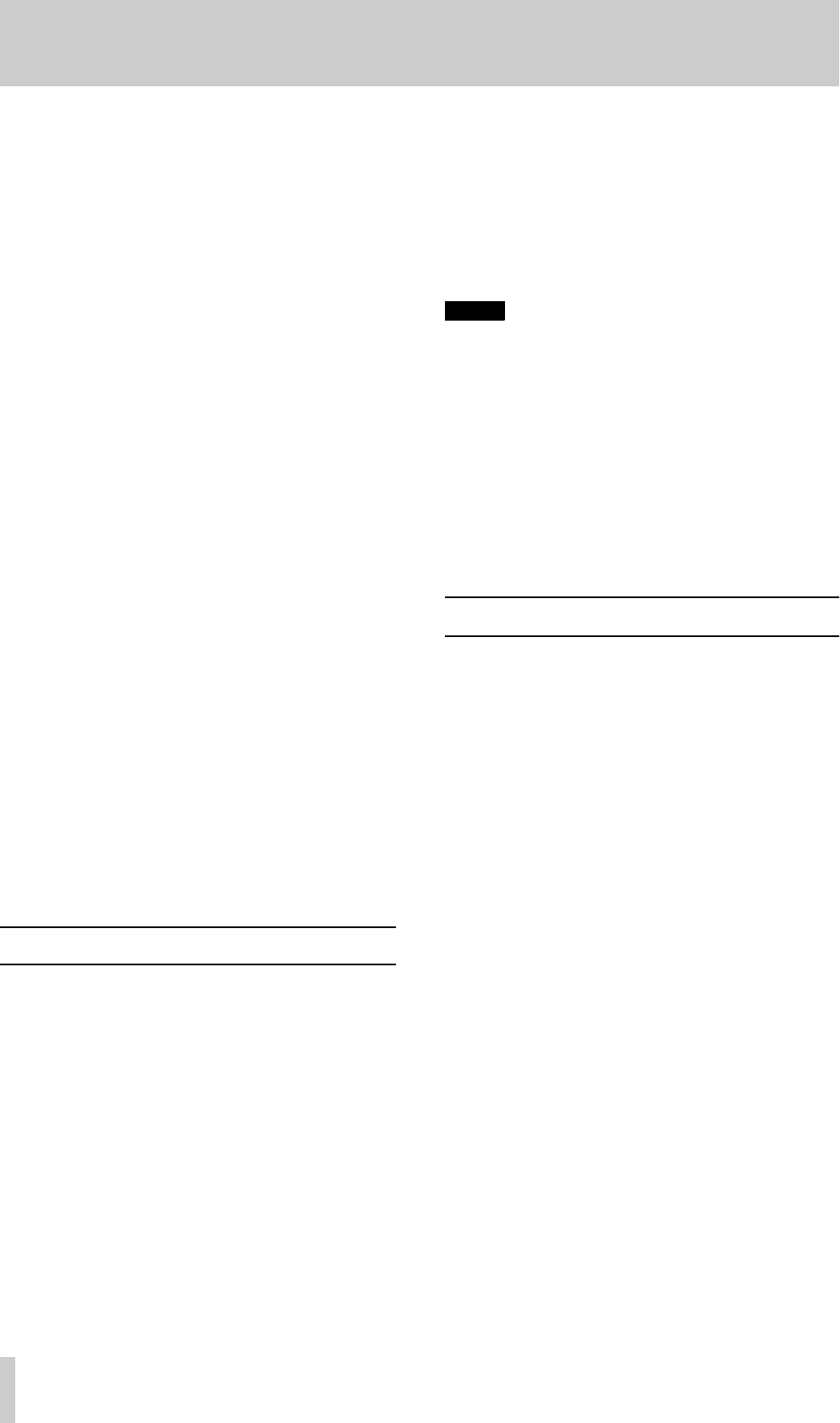
2 - Front and rear panel features
15
TASCAM DA-78HR
M
REPEAT (MENU) key and indicator
This key is used to provide a repeat function between
the two location points (see 7.2, “Repeat function”).
When the DA-78HR is shift mode, it allows selection
of the top-level menus (see 4.3, “Menus and sub-
menus”).
N
CHASE (SUB MENU) key and
indicator
This key is used to set the DA-78HR to a slave chase
mode, either to another DTRS unit, or to timecode
(see 8.2.3, “Master/slave settings (CHASE mode)”
and 9.6, “Chasing to timecode”).
When the DA-78HR is in shift mode, it allows selec-
tion of the second level of menus in the menu tree
(see 4.3, “Menus and sub-menus”).
O
LOC 1 (MEMO 1) key
This key locates the tape to the position set by
MEMO
1
(this key used with the
SHIFT
key). See 7.1,
“Autolocation” for details.
P
LOC 2 (MEMO 2) key
This key locates the tape to the position set by
MEMO
2
(this key used with the
SHIFT
key). See 7.1,
“Autolocation” for details.
Q
MIXDOWN (LEVEL/PAN) key and
indicator
This key turns the 8 x 2 sub-mixer output on and off
from the rear panel outputs. See 7.4, “Sub-mixer” for
details.
When the DA-78HR is in shift mode, this key is used
to set the level and the pan position of each track in
the sub-mixer image (7.4, “Sub-mixer”).
2.4 Track controls
R
REC FUNCTION keys and indicators
These eight switches and indicators allow the setting
and viewing of the record status on a track-by-track
basis.
When one of these switches is pressed, the appropri-
ate indicator will flash, the track is “armed”, and
going into record mode will start recording on that
track. When recording is being carried out on a track,
the track’s indicator will light steadily.
In addition, these keys are also used to select tracks
and channels for different operations, including the
input and output patchbays, the delay and sub-mixer
functions. See 7.3, “Track delay”, 7.4, “Sub-mixer”
and 5.3, “Input selection” for details of these
operations.
S
Peak meters
These 15-segment peak meters show the input level
or the recorded signal level, depending on the moni-
toring mode currently in operation (6, “Monitoring”).
NOTE
When using digital recording equipment, there is no
headroom above the 0 dB mark and no tape satura-
tion is possible. Any signal which causes the “OVER”
segment to light will cause audible distortion. For this
reason you should take care not to let recording lev-
els exceed this level.
The ballistics and peak hold times are selectable (see
7.8, “Meter modes”).
They may also be us ed to provide a quick visual
guide to the status of some of the settings (sub-mixer,
patchbay, etc.). See 4.1.1, “Peak meters” for details.
2.5 Rear panel features
See 3, “Connections” for full details of how to con-
nect the DA-78HR to other units.
T
REMOTE IN/SYNC IN
This connector is used to connect another “master”
DTRS unit (e.g. DA-78HR, DA-98, DA-88 or DA-
38). See 8, “Synchronization with other DTRS units”
for further details.
A TASCAM remote control unit may also be con-
nected here, but not all functions of the DA-78HR
may be available from the remote control unit.
U
MIDI IN/OUT/THRU
These connectors carry MIDI Time Code (MTC) and
MMC (MIDI Machine Control) commands as well as
MIDI System Exclusive messages. See 10, “MIDI
control” for details of how these facilities are used
when synchronizing to other units.
V
SYNC OUT
This is used to connect another DTRS unit in the
“daisy-chain” or, if this DA-78HR is the last unit in
the chain, to attach a termination plug.
W
REMOTE IN
Use this to connect an optional RC-808 remote con-
trol unit. Note that not all features of the DA-78HR
can be controlled using the RC-808.


















